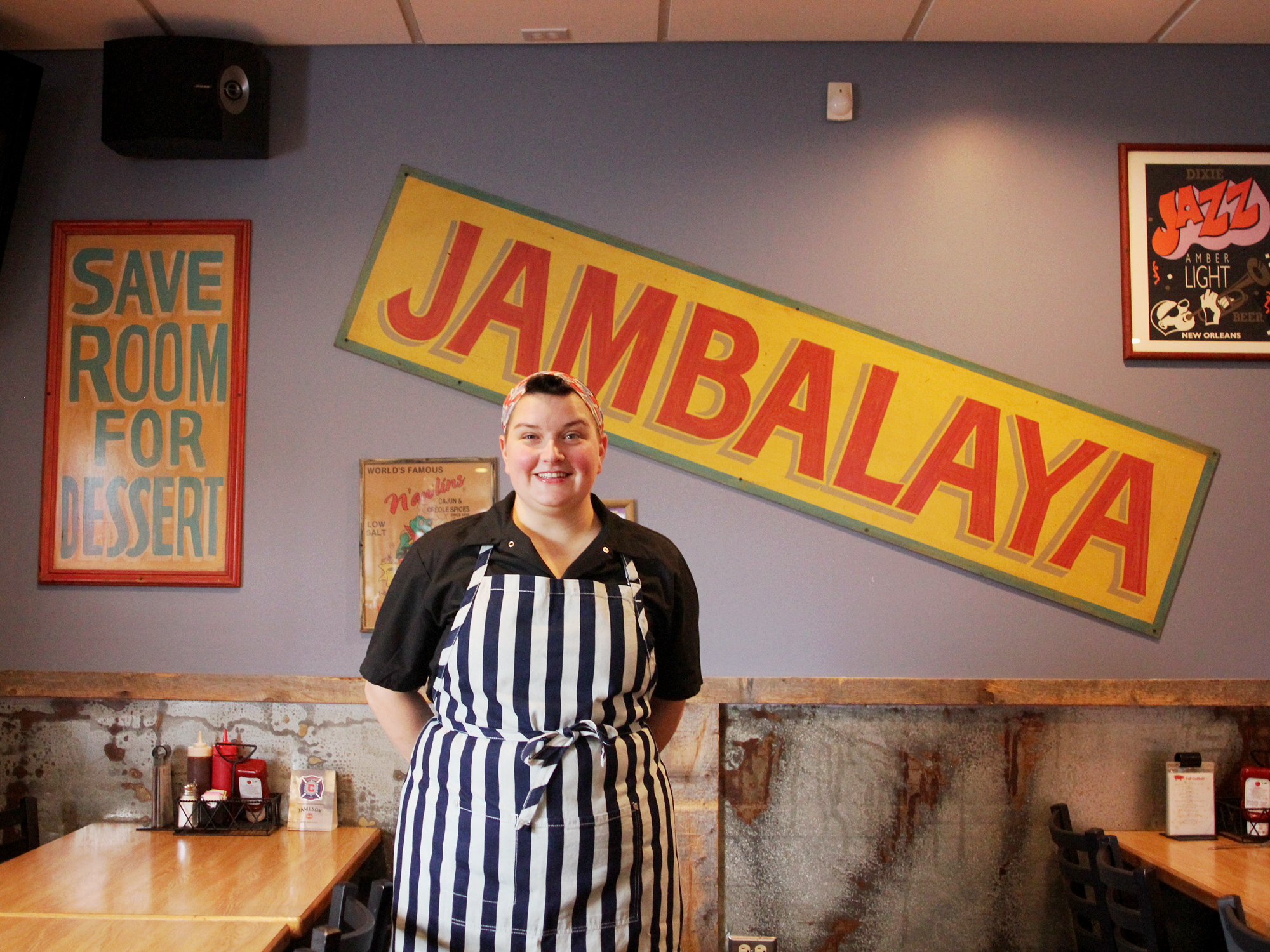THE REASON WHY PAUL FEHRIBACH IS INTERESTED in the grains that Glenn Roberts rediscovers, cultivates and makes available to restaurants is pretty obvious. “I’ve kind of been on this for a long time, because I like unusual ingredients that have good flavor,” the chef of Andersonville’s southern restaurant Big Jones says.
Roberts’ Anson Mills has been the supplier of especially flavorful Carolina Gold rice, grits and other Southern things to upscale chefs for a decade or two. But just as he likes poking around the more obscure corners of what grows—or once grew—in the South, Fehribach likes poking around Anson Mills’ product list to see what he can do differently using these rare grains. “If you do something that nobody else is doing, it makes your cooking distinctive. But it also gives me a whole other world of flavors and textures to explore,” Fehribach says.
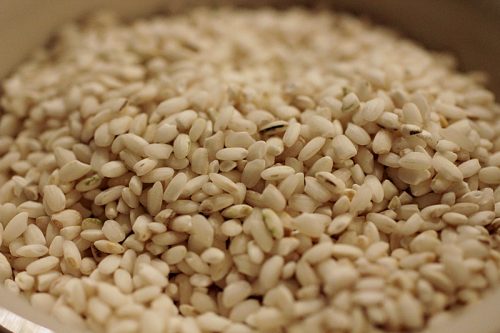
A cross of vialone nano and nostrali rice, suitable for risotto
He brings out four bowls filled with grains. The first is a cross of Italian rices called vialone nano and nostrali, both excellent for risotto. “Nostrali means ‘our rice,’ and it was brought to the Carolina lowcountry by Italian rice growers. Some would say it’s the ancestrally correct rice to make sea island bog,” he explains. I don’t actually know what “sea island bog” is, but it has a wonderfully atmospheric name, and I’d be happy to try it with this stubby little rice.
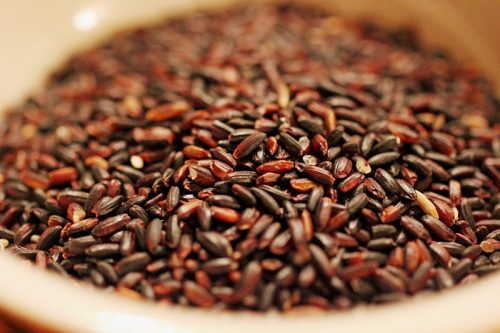
Jefferson red rice
The second is a dark red rice, called China Black, which somehow refers both to China as its country of origin (it’s the same as “forbidden rice”) and to a place called China, Texas, near Louisiana, where it’s grown. (Basically, you can’t be a Southern food without a slightly shaggy dog story like that.) The third, similar looking, is what Anson Mills calls Jefferson Red Rice, similar to a red rice that Thomas Jefferson imported from Italy.
The fourth isn’t a rice—it’s called brewster oats, because in medieval England, he says, the local beer maker, the brewster, was a citizen of importance and keeper of grains. So these tender oats, hull-less and thus oats that don’t need to be cut or rolled, were a prize worth being in good with the brewster for. “You can just eat them—give them a try,” Fehribach says. I pick up a few kernels and start chomping on them. They give off a great nutty, oat-y flavor.
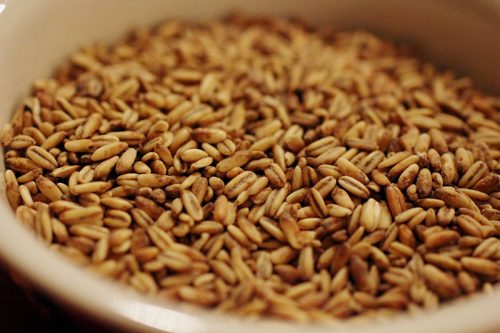
Brewster oats
“We make a savory oatmeal with them at brunch,” he says. “When I first started working with these, they reminded me of a hay loft. That grassy, almost sileage-y smell of hay. So I just instinctively wanted to cook them in that Kilgus cream, because it’s so pure and has a lot of that barnyard flavor to it.”
Besides the oatmeal, he uses the oats in, unexpectedly, cocktails. First, he makes an orgeat—which he explains was originally a milk substitute, an almond or oat milk, for drinks. And then the orgeat finds its way into a kind of shrub-tasting cocktail called an Upcountry Mist, where it’s mixed with the juice from the pickled peaches he puts up in the summer.

Orgeat (in cordial glass) and the Upcountry Mist, plus shortbread made in part with pea flour
FEHRIBACH LIKES THESE GRAINS FOR THEIR FLAVORS, but there’s also something else about using them that appeals to him. Which is that they’re all part of a trend that Glenn Roberts and others are part of, which is working back toward a more sustainable agriculture built on polycropping—growing different crops together—and perennials, which help protect soil against erosion and other problems.
“Wheat and corn technically are perennials—they’re grasses,” he explains. “But they don’t botanically function as grasses any more. They’ve morphed into annuals that grow themselves to death.”
“Perennial grains and polycropping are the leading edge of sustainable farming now,” he says. Besides Anson Mills, he’s watching what an Illinois farmer named Andy Hazzard is doing, preserving genetic lines that have been on her family’s farm for a century. (The bakery Hewn, in Evanston, works with some of what Hazzard grows, though the supply is still minuscule—Fehribach describes Hazzard harvesting wheat from a small patch with scissors.)
Another group whose work he watches closely is The Land Institute, near Salina, Kansas, which is aiming to turn wheat and other crops back into perennials. But their supply, again, is limited and basically not yet commercially available—he says Brooklyn’s artisan baker Bien Cuit is experimenting now with making croissants and laminated doughs from The Land Institute’s wheat, with an eye toward commercialization to other bakers down the road.
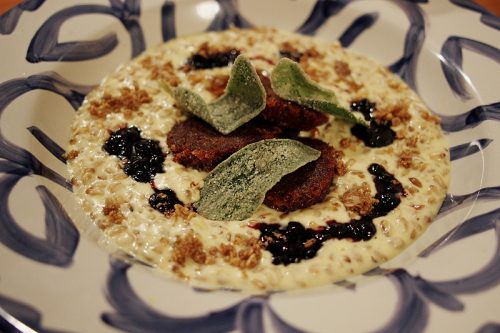
Brewster oatmeal with duck sausage, fried sage and huckleberry jam
He’s interested in these new things in grain farming… because they’re the old things in grain farming. Most of these grains date back to the 19th century—”Grains, starting in the mid 1800s, was an age of experimentation, and all of this crazy rapid crop breeding set the stage for the green revolution” in the mid-20th century. Polycropping, too, is an old technique made new.
“Growing corn and beans together, that’s an old story in the South,” Fehribach says. “Instead of planting a field of rice, you plant rice, peas, and corn, because different plants use different micronutrients. A really deep-rooted rice like Carolina Gold is going to feed on the soil a different way than a short-rooted rice.” There are other benefits to growing different kinds of plants—”There’s more security to it. In China, Texas a couple of years ago they had huge storms, and the China Black gets carried off. But Carolina Gold, which is as tall as I am, is sitting there with its head above water, and it’s happy as can be.”
If you look at old cookbooks, they’re using chestnut flour, acorn flour—this idea of wheat as the basis of our pantry is really new.
But at some point, besides digging the cool story, you have to actually make something with the grains you buy. What does Fehribach make, besides oat orgeat? “We’re still in the experimental stage with a lot of them,” he says. “We’ve got some Scots bere barley, we’re using the Calico rice [a polycrop of different rices, harvested together] on a special basis, trying to figure out what we like it for. It makes really nice rice cakes.”
Peas are a traditional ground cover in the South, and pea flour—ground dried peas—is one ingredient he’s made good use of. Though he has mixed feelings about all the different varieties Anson grows, feeling some can be too dirt-tasting (one variety, for instance, is called red clay peas, because they taste like eating clay).
But a shortbread he makes for desserts is part pea flour, and he uses it in rösti, a Swiss potato and cheese dish popular in the South—an idea he got from James Beard Foundation Award-winning cookbook author Ronni Lundy, who visited Big Jones for a book signing earlier this year. “It’s basically like pakora—in Indian cooking you’d use chickpea flour, so pea flour isn’t far from that.”

Rösti, made with pea flour
There’s another benefit to using pea flour—it means the rösti is gluten free. Fehribach doesn’t necessarily aim to have a heavily gluten free menu, but he says it happens naturally. “We make old school southern cornbread without any wheat flour, and there’s so much corn and rice on the menu that it’s not hard to make a gluten free meal. If you look at old cookbooks, they’re using chestnut flour, acorn flour—this idea of wheat as the basis of our pantry is really new.”
So how do customers like his use of these unconventional grains in baking? I ask. He laughs.
“We get people at brunch all the time, who just want to know, ‘Do you have any normal pancakes,’ they call them, or ‘white pancakes.’ Because right now we’re using oat flour with sweet potatoes for sweet potato pancakes. The buckwheat pancakes that we always have on the menu—we use Sobakoh buckwheat, that’s a Japanese buckwheat from Anson Mills. Or Carolina Gold rice flour or benne flour— they’re all these robust, big flavored pancakes. If somebody don’t like it, I’m like, come back in July, when we’re doing rice flour pancakes with fresh raspberries, maybe you’ll like that better.”
“If I ever have an epitaph, although I’ll probably be cremated, it’ll be, ‘I pulled off brunch without toast or white pancakes,'” Fehribach says.
Michael Gebert is ye olde editor of this esteemed periodical.
Latest
Join the Discussion
After you comment, click Post. If you're not already logged in you will be asked to log in or register with Disqus.






